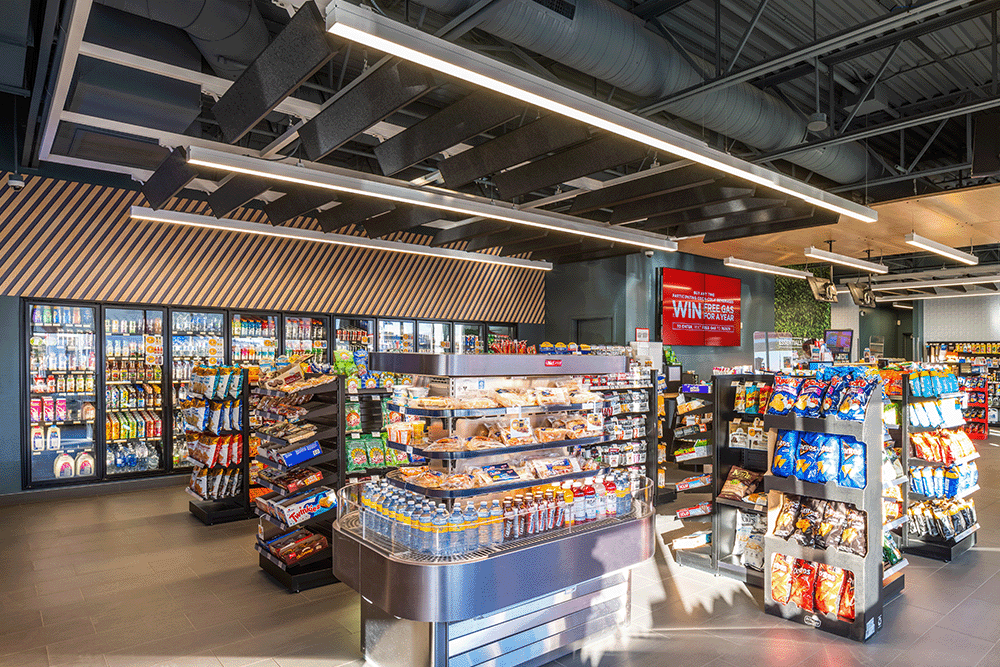9:15 am
The Drive Towards Greener Gas Stations and Convenience Stores

Embarking on the green transformation of gas stations and convenience stores isn’t just a commitment to sustainability – it’s a smart business move. With CTM Engineers and Architects guiding you in your renovation, you’ll not only cut down on energy consumption but also pave the way for a greener, more efficient, and more profitable future for your gas station and convenience store.
Lighting
A great place to start with your energy-efficient renovation plans is lighting. Upgrading to LED lighting is not only a cost-efficient way to save energy and improve the look of your store, but it also generates significantly less waste heat, which improves comfort while you save on cooling costs.
It’s also helpful to utilize natural lighting through the placement of skylights and windows to minimize reliance on artificial lighting during the day. In colder climates, it’s advantageous if the windows are south-facing, as they typically get the most light, and can help keep your store warm and bright when it’s cold outside.
When considering exterior lighting, you may want to consider upgrading to exterior rugged LED lights, including canopy, parking lot, and signage lighting.
Motion and occupancy sensors
Implementing motion sensors in less trafficked outdoor areas offers a straightforward way to save energy. Similarly, installing occupancy sensors in restrooms and storage rooms can automatically manage lighting, further reducing energy use while also improving the customer experience (for those of you who don’t enjoy touching the bathroom light switch, this is for you).
These sensors ensure lights are on only when needed, maximizing energy savings while providing customers with a small but delightful modern convenience.
HVAC systems
Heating and cooling often make up the largest share of energy costs for convenience stores.
Advanced HVAC systems equipped with high-efficiency components like Electronically Commutated Motors (ECMs) or Variable Speed Drives (VSDs) can significantly reduce that large slice of the energy pie.
Electronically Commutated Motors (ECMs) are highly efficient electric motors known for their energy efficiency, especially under partial load conditions, as well as for their ability to precisely adjust speed. ECMs are widely used in applications such as HVAC systems and refrigeration, where precise control and energy savings are critical.
A Variable Speed Drive (VSD) is a device that controls the speed of an electric motor by varying electrical supply frequency and voltage. It allows for precise speed control, enabling motors to operate more efficiently and use energy only as needed. VSDs are commonly used in systems such as pumps and fans; actively adjusting the speed rate of motors based on building energy load demands.
When considering an HVAC system, be sure to note those with a high SEER rating (Seasonal Energy Efficiency Ratio). Systems with a high SEER rating are not only more energy efficient but often come with advanced features that improve overall comfort and air quality in your space.
Virtually all modern HVAC systems now use programmable thermostats to both enhance energy efficiency and allow for precise control over the indoor climate. These thermostats enable users to customize heating and cooling schedules to fit your store’s operations, helping minimize energy use when the space is unoccupied or when demand is low.
Importantly, after your new awesome HVAC system is in place, make sure the schedule on your thermostat is up-to-date and ensure regular HVAC maintenance occurs. Also, be sure ductwork is insulated, sealed, and cleaned regularly to prevent energy loss through leaks and obstructions.
Refrigeration
Just like upgrading an HVAC system can lead to significant energy savings, swapping out old refrigeration units for newer, more energy-efficient models can also cut down on electricity usage. These modern refrigeration units also often come equipped with VSDs and ECMs, which optimize energy use by adjusting the speed of the compressor and fans based on the cooling demand.
In addition to high-tech upgrades, a simple yet effective strategy for saving energy with refrigeration is the use of night covers on open display cases. This measure helps to maintain the cold air within the unit during off-hours.
Just like your HVAC system, also ensuring that refrigeration units are serviced regularly can prevent minor issues from turning into major energy drains. This includes checking that the thermostat is set to the optimal temperature—a balance that keeps products fresh without overworking the refrigeration system. Known as the “Goldilocks zone,” this ideal temperature setting avoids the extremes, ensuring the unit isn’t working harder than it needs to.
Building envelope
Insulation in your walls and roofing helps maintain a comfortable internal temperature while reducing the workload on heating and cooling systems. Installing energy-efficient, double-glazed windows is a great way to reduce energy loss, while sealing openings with weather stripping and caulking helps prevent drafts. What’s more, fitting doors with automatic closers and energy-efficient frames will help your store minimize energy waste through openings.
All these building envelope upgrades help save on HVAC costs in two ways – firstly – an efficient building with good air sealing could potentially be fitted with a smaller, more affordable system. Secondly – an efficient building envelope will reduce the burden on HVAC, which in turn saves on running costs.
Renewable energy sources
Installing solar photovoltaic (PV) panels on unused spaces like rooftops or over-parking canopies allows convenience stores to tap into the sustainable and abundant energy of the sun.
Solar water heaters, which pre-heat water for hot water tanks using black exterior pipes, are a cost-effective and reliable option for convenience stores in locations with abundant sun.
Similarly, considering the integration of ground source heat pumps into the building’s design offers an effective way to utilize the earth’s stable ground temperature for heating and cooling. These systems are renowned for their efficiency, utilizing the constant underground temperature to regulate your building’s climate more naturally.
Water heating
Switching to high-efficiency water heating systems, such as tankless water heaters, is a strategic move for reducing energy consumption in any building. These systems are designed to provide hot water on demand, eliminating the need to always maintain a reservoir of hot water and significantly cutting down on energy usage.
Additionally, insulating hot water pipes is an effective way to prevent heat loss as water travels from the heater to the faucets. This simple measure ensures that water arrives at its destination with minimal temperature drop, reducing the need to further heat the water and thereby saving on energy costs.
Water conservation
Opting for low-flow fixtures in restrooms, such as faucets, toilets, and urinals, is a practical approach to conserving water. These fixtures are engineered to use water more efficiently, fulfilling cleaning needs and flushing effectively while minimizing waste. This adjustment can lead to a significant reduction in water consumption without sacrificing functionality.
For landscaping, choosing drought-resistant plants and implementing drip irrigation systems can transform how outdoor spaces consume water. Drought-resistant plants thrive with minimal water, reducing the need for frequent irrigation. Drip irrigation systems complement this by delivering water directly to the roots of plants, which decreases water loss through evaporation and runoff, ensuring that every drop of water is used effectively.
Moreover, embracing gray water recycling systems offers a great opportunity to further conserve water. By capturing, treating, and repurposing gray water (think rainwater or water from your sink) for non-potable uses such as toilet flushing and watering landscapes, convenience stores can decrease their freshwater demand.
Transportation and fuel pumps
For gas stations aiming to enhance efficiency and reduce their environmental footprint, investing in the latest fuel pump technology is a smart strategy. Modern pumps adjust their output based on demand, ensuring no energy is wasted during low-usage times. Regular upkeep of these systems is critical, as it maintains optimal performance and helps to avoid leaks.
Integrating vapor recovery systems is another innovative approach. These systems capture evaporating fuel vapors before they can be released into the air, recondensing them back into liquid fuel. This not only minimizes the release of volatile organic compounds (VOCs) but also boosts the station’s operational efficiency by recapturing fuel that would otherwise be lost.
Sustainable materials and waste reduction
Choosing recycled materials or those with low levels of VOCs for renovation projects can lessen the environmental footprint of a business. These materials not only contribute to healthier indoor air quality but also help support businesses producing sustainable or recycled materials, further reducing the demand for raw materials.
Implementing a well-organized recycling program, along with any needed recycling infrastructure for both customers and staff, is another step toward a more sustainable operation. By providing clear instructions and convenient recycling stations, businesses can significantly increase the number of materials recycled.
Appliances
Convenience stores aiming to enhance their efficiency should consider upgrading to ENERGY STAR-rated refrigerators, freezers, and beverage coolers, which have been designed to consume significantly less electricity and water, making them ideal for businesses looking to reduce utility expenses and environmental impact.
Energy management systems
Implementing a straightforward energy management system (EMS) allows for the centralized control and monitoring of a store’s energy usage, from lighting to HVAC to refrigeration systems.
For instance, it could adjust lighting intensity based on natural light availability or store occupancy, ensuring energy isn’t wasted on unnecessary lighting. It could also regulate the store’s heating and cooling systems to operate more efficiently, maintaining optimal temperatures without overuse.
Furthermore, the EMS could oversee refrigeration units, alerting management to deviations from normal operation that may signify inefficiencies or malfunctions requiring maintenance.
Bring sustainability and success to your convenience store & gas station
As a store owner, stepping into the realm of energy efficiency and sustainability isn’t just an operational upgrade; it’s a commitment to a smarter, greener way of doing business that resonates with today’s eco-aware customers. It’s a clear message to your customers and the industry: sustainability and success are not mutually exclusive; they are indeed complementary.
